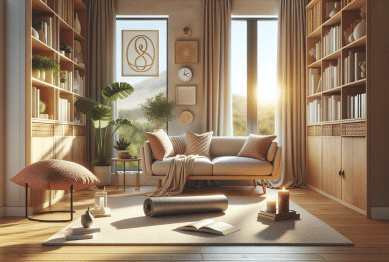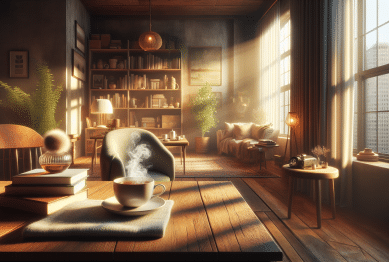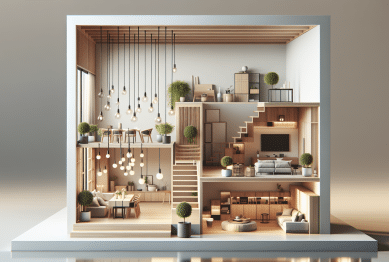Curious about how minimalist living can shift your daily routines, finances, and well-being? Dive into this engaging guide exploring intentional choices, calming declutter strategies, and the surprising impact of less stuff on your lifestyle.
The Essence of Minimalist Living
Minimalist living focuses on simplifying life, keeping only what adds value, and eliminating clutter. It’s not about empty rooms, but about creating purposeful spaces and routines. Many find that decluttering boosts focus, reduces stress, and leads to more intentional living.
At its core, minimalism is about mindful consumption. By questioning what truly serves a purpose, people break cycles of impulse buying and enjoy homes that feel lighter and easier to maintain. The reward is not in emptiness but in appreciating what remains—and the peace it brings.
Minimalism also reshapes priorities. With fewer possessions, people often spend more time outdoors, on hobbies, or with loved ones. It can inspire healthier work-life balance, more rest, and deeper connections. The result is a grounded lifestyle where each choice supports well-being rather than clutter.
Decluttering Strategies That Work
One of the most practical steps in minimalist living is learning how to declutter effectively. Many experts recommend starting small—a single drawer, a stack of papers, or the kitchen counter. Setting clear intentions can make a significant difference. Ask, ‘Do I use this regularly?’ or, ‘Does this item serve a clear purpose?’ When an object no longer provides value or joy, it’s time to consider donating, recycling, or responsibly discarding it. Decluttering can feel overwhelming, but breaking down the process into manageable parts keeps motivation high. Witnessing progress, no matter how minor, reinforces your commitment to minimalism.
There are multiple decluttering methods, each tailored to different personality types. The KonMari method focuses on evaluating items category by category, holding each thing to discern if it ‘sparks joy.’ Other strategies, such as the 12-12-12 challenge, encourage finding twelve items to throw away, donate, and relocate. These structured plans offer concrete steps and make the process more approachable, especially for beginners. Research from the National Association of Productivity & Organizing Professionals (https://www.napo.net/page/benefits-minimalist) highlights the emotional relief experienced as physical clutter decreases, often accompanied by improved relaxation and productivity.
Mindful decluttering can also extend beyond physical objects. Digital spaces—phones, computers, and email inboxes—also benefit from applying the minimalist mindset. Unsubscribing from emails, deleting unused apps, and organizing digital folders can reduce mental clutter, much like tidying a room. Over time, regular decluttering becomes a gentle habit. Less visual and digital noise means it’s easier to focus, respond to challenges calmly, and prioritize what matters most. The benefits extend into daily life, supporting a sustainable shift toward simplicity and intentionality.
The Hidden Benefits of Owning Less
One major appeal of minimalist living is its surprising impact on well-being. Studies show that excess clutter can raise stress levels and negatively affect mood. By intentionally reducing what you own, you create a calming environment that fosters relaxation. A tidy space signals safety and comfort to the brain, making it easier to unwind after a busy day. Many minimalists report improved sleep, sharper concentration, and heightened creativity in streamlined environments. Having fewer things allows you to better appreciate those you keep, infusing your surroundings with intention and positivity.
Owning less can also boost financial wellness. Minimalism shifts focus from acquiring the newest trends to making thoughtful purchases you truly need. This mindset naturally curbs impulsive spending, freeing up resources for savings, experiences, or quality investments. For some, it translates into downsizing homes, using public transportation more often, or adopting energy-saving habits. These choices not only benefit personal finances but often support broader sustainability goals, aligning your actions with eco-friendly values and community well-being. Minimalist living even encourages sharing or borrowing within communities, strengthening relationships and reducing overall consumption.
The psychological rewards of living with intention are subtle but powerful. A minimalist lifestyle can nurture greater self-awareness, patience, and gratitude for the everyday. Clearing physical clutter often clears mental space, too, making room for new ideas and meaningful experiences. Rather than chasing endless ‘wants,’ you become attuned to genuine needs, leading to greater life satisfaction. In the long-term, these habits reinforce emotional resilience, helping individuals better handle challenges and savor simple joys. It’s a cycle—less leads to more: more time, more freedom, and greater clarity.
Designing Spaces for Calm and Clarity
Minimalist design is not about empty shelves but about intentional choices. It emphasizes functional furniture, natural light, and uncluttered surfaces. Neutral tones, clear counters, and multipurpose pieces foster a sense of openness and tranquility. By choosing fewer, higher-quality pieces, your living area becomes visually lighter and easier to keep tidy. Research from interior design experts at The Spruce (https://www.thespruce.com/minimalist-home-design-tips-5074026) confirm that intentional design influences mood, energy levels, and even social interactions. Minimalist décor is calming, creating a gentle background for work, play, and rest.
Space planning is key to successful minimalist living. Multipurpose furniture—such as ottomans with storage, extendable tables, or foldaway beds—maximizes available room without adding bulk. Plants are popular additions, providing pops of color while purifying the air. Clever storage ideas, like floating shelves or under-bed bins, keep frequently used items handy but out of sight. The result? A peaceful, breathable home that feels organized rather than sterile. Design decisions become more intentional, with every item earning its place by contributing to ease, comfort, or aesthetic harmony.
Personal touches bring warmth and personality to minimalist spaces. Curated collections of art, favorite books, or family photos can be displayed thoughtfully without clutter. For many, the process of refining personal spaces becomes an ongoing creative project, evolving as needs and tastes change. As your environment becomes more peaceful, the benefits ripple outward, supporting rest, creativity, and your overall sense of well-being. Minimalist design invites you to live at your own pace—thoughtfully, purposefully, and with gratitude for your surroundings.
Minimalism’s Surprising Effect on Daily Routines
As minimalist living takes root, routines change—often for the better. Mornings become smoother with fewer wardrobe decisions and less rushed preparation. Many who practice minimalism create capsule wardrobes, with a handful of versatile pieces that suit most occasions. This cuts down decision fatigue and frees up energy for other tasks. Kitchens organized with basic, multipurpose tools make meal prep quicker and encourage more mindful eating habits. With simpler routines, it’s easier to notice moments of joy and connection. Fewer possessions lead to less time spent managing—more time spent living.
Minimalist routines extend beyond the home. Some individuals reassess their digital habits, limiting time on social media or focusing on deeper, more meaningful online engagement. This approach reduces distractions and curbs the anxiety associated with information overload. Many notice improved productivity and more fulfilling leisure time. With less clutter in schedules and spaces, energy levels rise, and creativity flourishes. Research shared by Harvard Health Publishing (https://www.health.harvard.edu/mind-and-mood/simplicity-and-minimalism-reduce-stress) notes that simplicity can help foster good mental health by reducing competing demands and overstimulation.
Minimalism encourages regular reflection—a habit that also shapes thoughtful routines. Reviewing what’s working and letting go of what isn’t supports ongoing growth and contentment. Over time, mindful rituals such as journaling, meditation, or even short daily walks become staples in a minimalist lifestyle. These habits encourage presence, gratitude, and adaptability. Minimalist living isn’t a rigid formula but a flexible framework for creating days filled with meaning. The aim? To support health, happiness, and ease in everyday life.
Is Minimalism Right for You?
Minimalist living isn’t a one-size-fits-all answer, but it offers practical strategies for anyone seeking a calmer, more focused existence. If constant clutter, excessive choices, or overwhelming schedules are a source of strain, exploring a minimalist approach may help. Take time to identify what adds value and what distracts. Sometimes, even small changes—clearing a shelf, simplifying meals, or reframing shopping habits—can yield surprising relief. For many, minimalism is a gradual process, shaped by individual needs and goals.
Consider starting with a single area of your life: a junk drawer, your morning routine, or a calendar packed with commitments. Notice how adjustments in one space impact your energy, mood, or relationships elsewhere. There are no rigid rules in minimalism—just a commitment to living with greater intention. Explore what resonates most, and remember that each step is progress. Many find that the journey, not just the outcome, brings lasting benefits.
Minimalist living thrives on personalization. As you learn what serves you best, adapt the principles to fit your lifestyle. Let your surroundings reflect who you are and what brings joy. The minimalist path is about freedom, not deprivation—a way of making space for more of what truly matters. Whether you choose a few tweaks or a complete overhaul, each intentional choice supports a more centered, peaceful, and empowered life.
References
1. National Association of Productivity & Organizing Professionals. (n.d.). Benefits of Minimalist Living. Retrieved from https://www.napo.net/page/benefits-minimalist
2. The Spruce. (n.d.). Minimalist Home Design Tips. Retrieved from https://www.thespruce.com/minimalist-home-design-tips-5074026
3. Harvard Health Publishing. (n.d.). Simplicity and Minimalism Reduce Stress. Retrieved from https://www.health.harvard.edu/mind-and-mood/simplicity-and-minimalism-reduce-stress
4. Mayo Clinic. (n.d.). Declutter Your Life. Retrieved from https://www.mayoclinic.org/healthy-lifestyle/adult-health/expert-answers/declutter/faq-20058045
5. Psychology Today. (n.d.). The Psychological Benefits of Minimalism. Retrieved from https://www.psychologytoday.com/us/blog/the-new-grief/201901/the-psychological-benefits-minimalism
6. UC Berkeley Greater Good Science Center. (n.d.). Why Less Stuff Brings More Happiness. Retrieved from https://greatergood.berkeley.edu/article/item/why_less_stuff_bring_more_happiness









